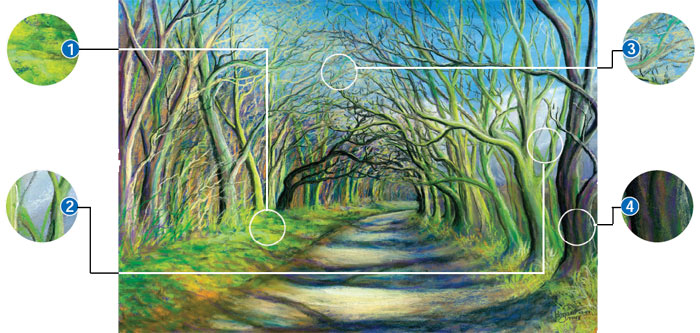Pastel Pencils

Although they are beautiful, pastels are certainly not the cleanest medium to use. With Derwent's pastel pencil you can enjoy all the beauty of a pastel, but without the mess! These wood cased Pastel Pencils have a soft, powdery texture which produces a velvety smooth finish. The product range features 72 colours which have the same brilliance as a regular pastel, but without their inconveniences! The wooden case makes the pastel much easier to control and apply detail, which can then be smudged and manipulated with precision.
These round 8mm diameter pencils with an extra wide 5mm strip are ideal for soft expressive studies. They are a medium pastel with a slightly chalky feel but also able to achieve a fine point. They have a soft powdery texture which means they can be mixed and blended well but because they are encased in wood you do not get the mess associated with a pastel block.
Available individually, in tins of 12, 24, 36, 72 as well as a tin of 12 portrait (skin) tones.
Ten Top Tips - By Carole Massey
Use the side of the pencil for broader areas of colour and the tip for drawing and detailed work.
To blend pastels you can use a paper stump, a rubber shaper or your finger.
Blend several similar colours together to enhance or heighten a colour e.g. two or three blues or greens
Apply diagonal lines (hatching and cross hatching) of pure colour without blending, this also helps prevent colours becoming ‘muddy’.
Always work with sharp pencils. Use a pastel pencil sharpener or sharpening stand and craft knife to sharpen and a sandpaper block to hone the tip to a fine point.
Hatch large areas with one colour to create an overall harmony or to bring several areas together
Create interest by varying the marks you make. Use both smooth blended areas as well as directional hatching marks.
Follow the maxim ‘light against dark, dark against light’ to increase tonal contrast and bring life to your drawings.
Dab with a kneadable eraser to remove excess pastel or shape it to a point to lift out highlights.
White is more effective used directly on the paper, not over other layers of pastel.
Hints and Tips
Pastel Pencils are more delicate than normal pencils, so when sharpening them be sure to take care. Keep the pencil in a straight line. Do not insert the pencil at an angle or the point will be subjected to unnecessary pressure and may break. Alternatively you can use a craft knife to sharpen your Pastel Pencil. Always ensure your blade or sharpener is sharp, pastel by it’s very nature causes a blade to blunt more quickly than normal pencils.

1. Tinting. Gently add colour to another and softly rub to merge the 2 colours together.
2. Sfumato. Rub pigment into the grains of the paper to leave a misty effect.
3. Feathering. Stroke or ‘feather’ pastel colours into each other to draw areas of tone lightly together.
4. Overlaying. Layer colours on top of each other to create new colour hues and add tonal depth.










